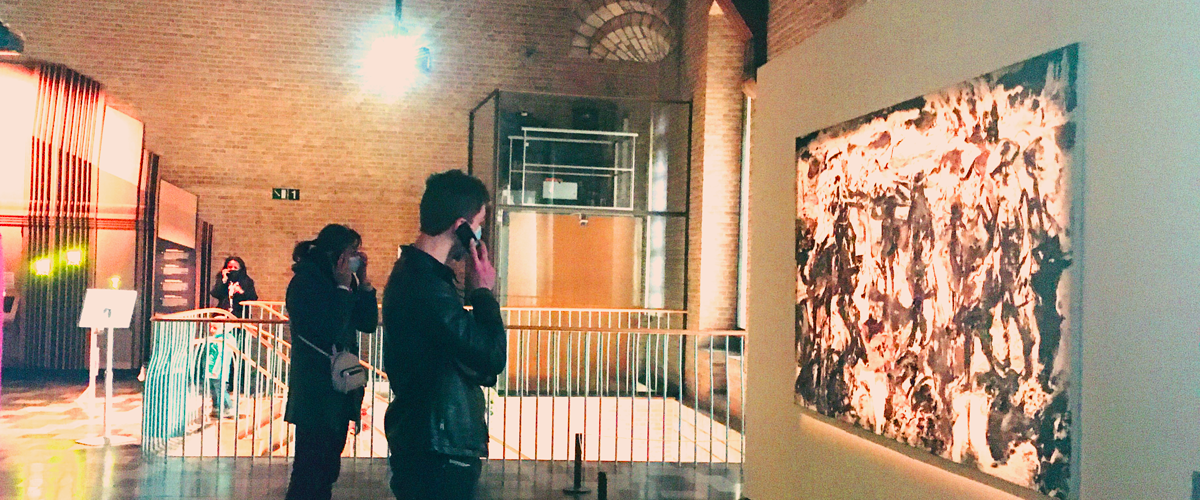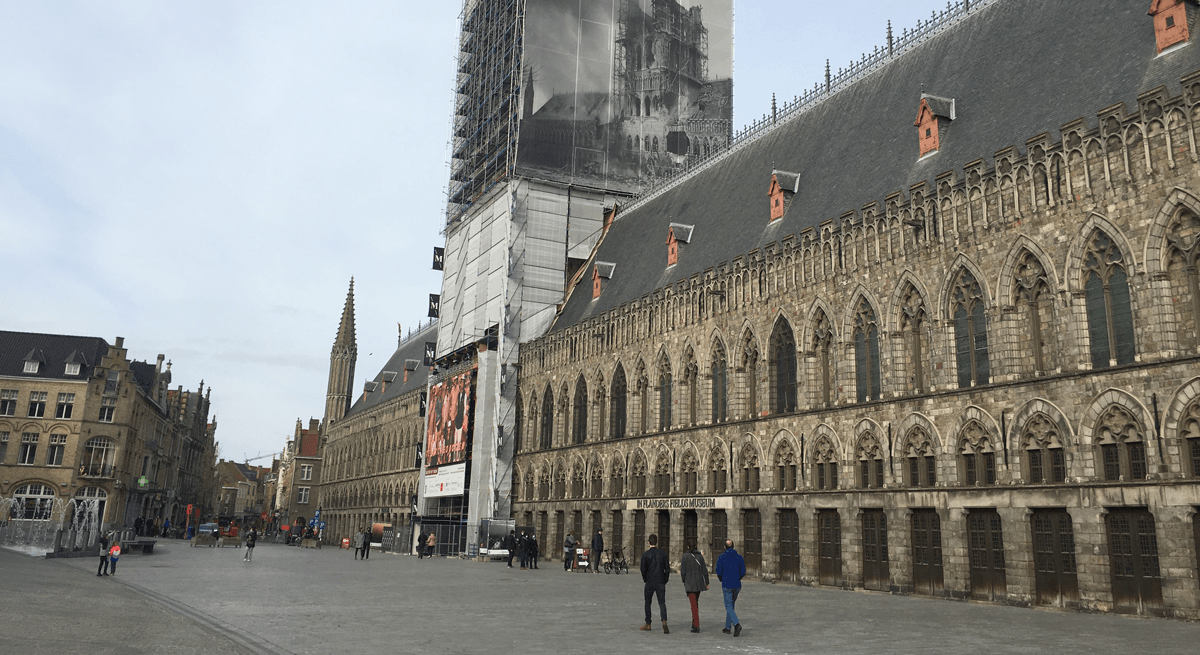The In Flanders Fields Museum comes back to life
Isabel Lowyck • apr 28, 2021
Image copyright © Guide-ID
It certainly felt good to see a sign reading ‘FULLY BOOKED’ outside a museum. The In Flanders Fields Museum (IFFM), like many other Belgian museums, sold out during the Easter holidays. The weather and the Belgian travel ban undoubtedly made a difference. Museums, including the IFFM, remarked that many visitors were people who would not normally visit museums.
I asked Piet Chielens, director of the In Flanders Fields Museum, how he feels about this resurgence. “It’s fantastic to see people rediscover how meaningful their leisure time can be when museums are the only places open to offer ‘live’ cultural experiences. We hope that this continues to some extent once everything opens up again!
The number of visitors is obviously limited, and the audio guide means that people generally stay a little longer. Because of the coronavirus restrictions, we can only allow half as many visitors in comparison with other busy periods! They are now mainly Belgian, and largely Flemish, families with children. Belgians are always among our visitors, but in ‘normal times’ almost twothirds of visitors to IFFM are from abroad. Obviously, it’s because of our main subject, a World War. And that subject draws visitors from everywhere, especially countries in Great Britain and the British Commonwealth. To them, Ypres has always symbolized the huge sacrifices their countries made in the First World War. That feeling will always be with us. We hope to see these visitors again as soon as it is safe for them to return.”
The number of visitors is obviously limited, and the audio guide means that people generally stay a little longer. Because of the coronavirus restrictions, we can only allow half as many visitors in comparison with other busy periods! They are now mainly Belgian, and largely Flemish, families with children. Belgians are always among our visitors, but in ‘normal times’ almost twothirds of visitors to IFFM are from abroad. Obviously, it’s because of our main subject, a World War. And that subject draws visitors from everywhere, especially countries in Great Britain and the British Commonwealth. To them, Ypres has always symbolized the huge sacrifices their countries made in the First World War. That feeling will always be with us. We hope to see these visitors again as soon as it is safe for them to return.”

Image copyright © Guide-ID
I visit the museum on Friday 9 April, having reserved my ticket in advance: this is an absolute necessity in these coronavirus times. There is a queue outside and a sign stating ’fully booked’. The instructions on the ground are clear: maintain a distance of 1.5 metres. Waiting in the corridor, we think about the visit ahead: shall we take the audio guide? Shall we add a more immersive layer? The museum began to offer audio tours because individual visitors were asking for them. Business manager Peter Slosse says that in the past period, 1 in 2 visitors have taken the audio tour. This far exceeds expectations: the museum’s original estimate was 1 in 5.
I am assisted by a friendly receptionist. He asks if I’d like the audio guide. “Of course!” I reply. I congratulate him on the visitor numbers, and he says, “We are really happy that it’s so busy. The museum is vibrant again.” Just before I enter the museum, a host explains how to use the audio guide. Chielens then explains how the audio tour works. “The basic tour takes you to 40 listening points in the museum. Listening to all the clips on this route takes about an hour. The audio tour also allows us to add to our story. It has become the in-depth tour: offering background information on objects and specialized descriptions, without us having many of these objects in the collection or much space for them in the exhibition. This tour features colleagues, friends and specialists we have often worked with as well as our own scientific team.”
I am assisted by a friendly receptionist. He asks if I’d like the audio guide. “Of course!” I reply. I congratulate him on the visitor numbers, and he says, “We are really happy that it’s so busy. The museum is vibrant again.” Just before I enter the museum, a host explains how to use the audio guide. Chielens then explains how the audio tour works. “The basic tour takes you to 40 listening points in the museum. Listening to all the clips on this route takes about an hour. The audio tour also allows us to add to our story. It has become the in-depth tour: offering background information on objects and specialized descriptions, without us having many of these objects in the collection or much space for them in the exhibition. This tour features colleagues, friends and specialists we have often worked with as well as our own scientific team.”

Image copyright © Guide-ID
It is soon clear to me that the museum has indeed made a comeback. I’m certainly not alone in this. What I notice is the great diversity of the visitors. There also lots of young families with very small children using audio guides. How has the museum handled the development of a separate tour for children? Chielens: “Of course, our education team has years of experience with this exhibition. They know what appeals to children, and they also know the stories behind certain objects. They approached Gerda Dendooven with it, and she, in her own way, has turned it into an exciting and at times moving story in 18 stages.”
I, personally, was very impressed with the audio contribution on Sam Dillemans’ work. You hear the manager himself speaking with a passion and giving a more thorough explanation of the work. I also love the fact that this contemporary work offers a clear vision of war in our time. The stories of 100 years ago are still relevant today.
www.inflandersfields.be
I, personally, was very impressed with the audio contribution on Sam Dillemans’ work. You hear the manager himself speaking with a passion and giving a more thorough explanation of the work. I also love the fact that this contemporary work offers a clear vision of war in our time. The stories of 100 years ago are still relevant today.
www.inflandersfields.be
List of Services
-
Meet The Beacons: The Little Traffic Controllers of Your Exhibition Have you ever noticed when you’re wandering through an exhibit the museum audio guide in hand and suddenly the tour starts activating on it’s own and the narration begins to play — feels like magic, right? But there’s actually a technology behind it. Spoiler: it’s not Wi-Fi, and it’s not magnetic attraction either (well… kind of).Meet The Beacons: The Little Traffic Controllers of Your Exhibition
-
What Would Be the Best Tour Guide System for Groups? Tourism is booming. No matter where you go, every place has a story to tell. Millions of people around the world are eager to dive into adventure and uncover the secrets of towns, landmarks, museums, nature parks, and more. Whether on foot, by bus, or by boat, everyone is excited to explore.What Would Be the Best Tour Guide System for Groups?
-
How to Increase Museum Engagement with AudioHow to Increase Museum Engagement with Audio
TIPS and TRICKS Gaining real engagement today can be a challenge for museums and cultural spaces. The diversity of languages, ages, and interests makes it difficult to find the right approach for each visitor, and to truly connect with them.
But, how can museums improve engagement and offer visitors a truly memorable experience? There are several important factors to consider, such as identifying your audience, choosing the right type of content, determining the ideal tour duration, and selecting appropriate vocabulary and tone for narration.
So today, we’ve put together some helpful tips and tricks to show you the best ways to achieve real engagement in your space.
TIPS and TRICKS -
Guide-ID’s Ultimate Duo:
When hardware and software merge their super powers Batman and Robin, Mario and Luigi, Sherlock and Watson, Han Solo & Chewbacca—what do they have in common? They’re some of the most iconic duos of all time. And today, we have a new one to add to the list. Ready? Drums please… The Podcatcher Pro & Its Tour Editor Platform!
Guide-ID’s Ultimate Duo:
When hardware and software merge their super powers -
AI Meets Audio: How Guide-ID Is Helping Museums Rethink Tour Creation From faster workflows to multilingual storytelling, Guide-ID’s smart AI tools are changing the way museums engage their visitors.AI Meets Audio: How Guide-ID Is Helping Museums Rethink Tour Creation
-
House of Bols: Telling a 450-year-old story with modern tech Just around the corner from Museumplein in Amsterdam, is House of Bols the Cocktail & Genever Experience, a multisensory space that brings to life the fascinating story of one of the world’s oldest distilled spirit brands. Through immersive storytelling, visual design, aromas, and sound, visitors step into the vibrant world of Bols, which has been crafting flavors since 1575.House of Bols: Telling a 450-year-old story with modern tech